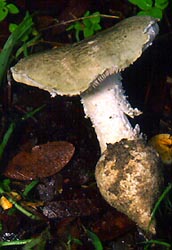[ Section Lepidella page. ]
[ Amanita Studies home. ]
[ Keys & Checklist/Picturebooks ]
[ Subsaharan List ]
"African Green Lepidella"


Technical description (t.b.d.)
BRIEF DESCRIPTION: The following is based on the description of Beeli ( 1935) with the addition of data from Bas (1969) and from a few recent collections, etc.
The cap is 50 - 100 mm wide, pallid to pale gray, and expanded convex. It is decorated with greenish to green to blue-green pulverulence of the volva which fades to brown and at last to pallid grayish. The cap's margin is nonstriate and appendiculate (at least at first).
The gills are narrowly attached to the stipe to free, white to pinkish white, attenuate at both ends, 5 mm broad, and with pulverulence along their free edges.
The exannulate stem is 130 - 140 x 6 - 20 mm, white, cylindric, with white pulverulence at the apex or in the upper quarter of its length. The stem's bulb is marked and turnip-shaped to spindle-shaped, and 25▒ mm wide.
The taste is bitter. The odor is slight to almond-like. Beeli says that bruising the flesh of the will cause a liquid to be exuded that carries an almond odor.
The spores [from recent collections from Zambia] measure (8.3-) 9.1 - 12.0 (-12.4) x (4.0-) 4.4 - 5.1 (-5.5) Ám and are elongate to cylindric and amyloid. [Bas ( 1969) examined the holotype and reports on spore measurements as follows: 8 - 9.0 (-10.5) x 4.5 - 5.5 Ám. The spores were ellipsoid to elongate to cylindric.] Clamps are absent from bases of basidia.
Beeli stated the species occurs with Gilbertiodendron (=Macrolobium) dewevrei.
The species was originally described from Congo and is known from Central Africa.
Bas placed A. odorata in his stirps Cinereoconia (see A. cinereoconia G. F. Atk. var. cinereoconia). -- R. E. Tulloss
Photos: David Arora (Zambia (Copper Belt Prov.))
[ Section Lepidella page. ]
[ Amanita Studies home. ]
[ Keys & Checklist/Picturebooks ]
[ Subsaharan List ]
Last change 17 July 2009.
This page is maintained by R. E. Tulloss.
Copyright 2003, 2004, 2008, 2009 by Rodham E. Tulloss.
Photographs copyright 2003 by David Arora.